Bone Health Risk Assessment Tool
Assess Your Bone Health Risk
Answer the following questions to estimate your risk of developing osteoporosis after menopause.
Your Bone Health Risk Assessment
Quick Takeaways
- Estrogen drops during Menopause mark the end of monthly cycles and trigger rapid bone loss.
- Bone density can decline 1-2% per year after the final period.
- Key defenses are weight‑bearing exercise, adequate Calcium the mineral that builds and maintains bone tissue, and enough Vitamin D the vitamin that helps the gut absorb calcium.
- Screen with a DEXA scan a low‑dose X‑ray that measures bone mineral density (BMD) at 50‑55 years or earlier if risk factors exist.
- When lifestyle isn’t enough, doctors may prescribe bisphosphonates medications that slow bone breakdown or consider hormone therapy.
How Menopause Triggers Bone Damage
During the reproductive years, estrogen works behind the scenes to keep bone‑remodeling balanced. It tells the cells that break down bone (osteoclasts) to slow down, while encouraging the cells that build bone (osteoblasts) to stay active. When a woman reaches menopause the natural cessation of ovarian hormone production, estrogen levels can fall by up to 90%, and that balance tips.
The immediate effect is an increase in osteoclast activity. Studies from the National Osteoporosis Foundation (2023) show a 2‑3% rise in bone turnover markers within the first year after the final menstrual period. If the increased breakdown isn’t matched by new bone formation, the net result is a loss of bone mass-particularly in the spine, hip, and wrist, the classic sites for fragility fractures.
Why does this matter? Because every 1% loss in bone density translates to roughly a 1.5% rise in fracture risk. After age 55, the risk curve steepens, which is why many women receive their first diagnosis of osteoporosis a condition where bones become porous and fragile in the decade following menopause.
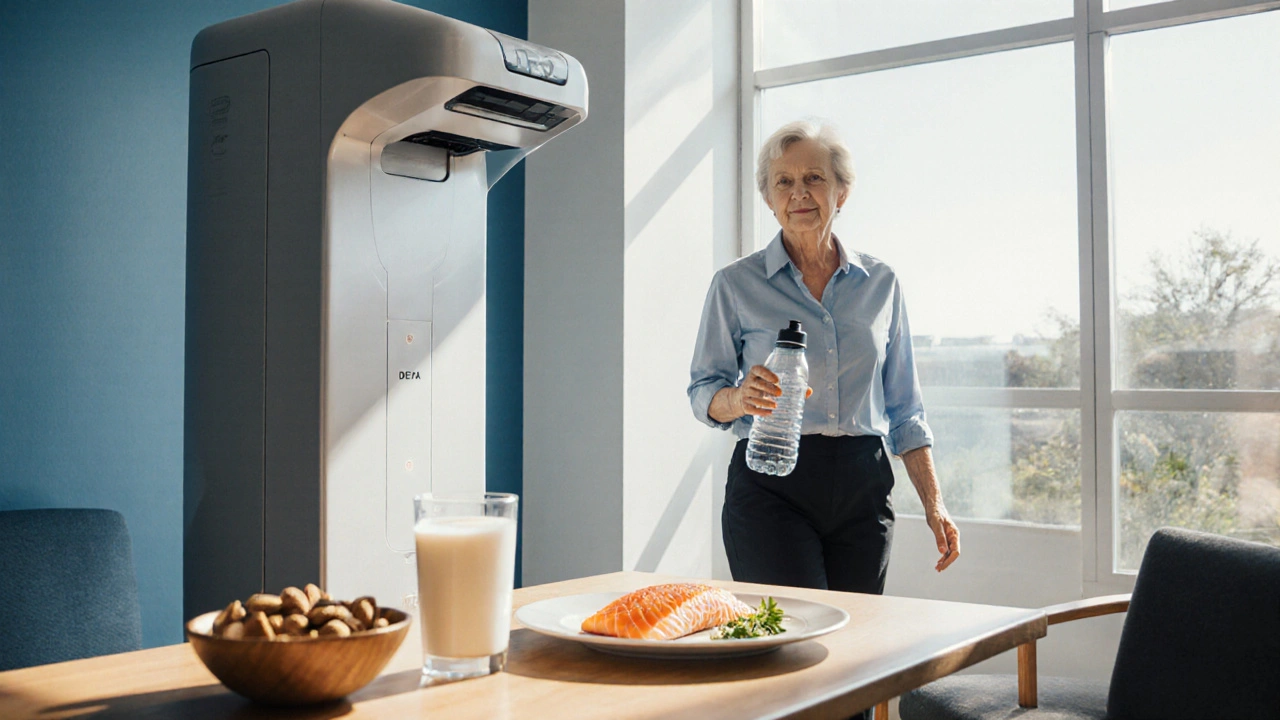
Spotting Early Signs of Bone Damage
Unlike a sprained ankle, bone loss is silent until a fracture occurs. Still, there are clues that can prompt a check‑up:
- Sudden loss of height or a stooped posture (often called “dowager’s hump”).
- Back pain that isn’t linked to a specific injury-spinal compression fractures can press on nerves.
- Frequent fractures from low‑impact falls, such as tripping over a rug.
- Family history of osteoporosis or early fractures.
- Low body weight (BMI < 18.5) or prolonged use of steroids.
If any of these tick boxes apply, talk to a GP about ordering a DEXA scan a dual‑energy X‑ray absorptiometry test that gives a T‑score comparing your bone density to a healthy 30‑year‑old. A T‑score of -2.5 or lower meets the WHO definition of osteoporosis.
Nutrition & Lifestyle: The First Line of Defense
Nutrition and movement are the cheapest, safest tools in the bone‑health toolbox. Below is a practical checklist you can start today.
- Hit the calcium target. Women 51‑70 need about 1,200mg of calcium daily. Dairy, fortified plant milks, sardines with bones, and leafy greens (collard greens, bok choy) are top sources.
- Don’t forget vitamin D. Aim for 800-1,000IU per day. Sunlight for 10-15 minutes a few times weekly works, but many UK residents need a supplement, especially in winter.
- Include protein. About 1.0-1.2g per kilogram of body weight supports bone matrix formation. Lean meat, beans, and dairy count.
- Weight‑bearing exercise. Activities like brisk walking, dancing, stair climbing, or light resistance training stimulate osteoblasts. The NHS recommends 150 minutes of moderate activity plus two strength sessions per week.
- Avoid excess alcohol and quit smoking. Both accelerate bone loss.
- Limit caffeine. More than 3 cups of coffee a day can increase calcium excretion.
While the above are simple, consistency is key. Bone remodeling is a slow process; you won’t see measurable changes in a month, but a year of adherence can preserve or even modestly increase density.
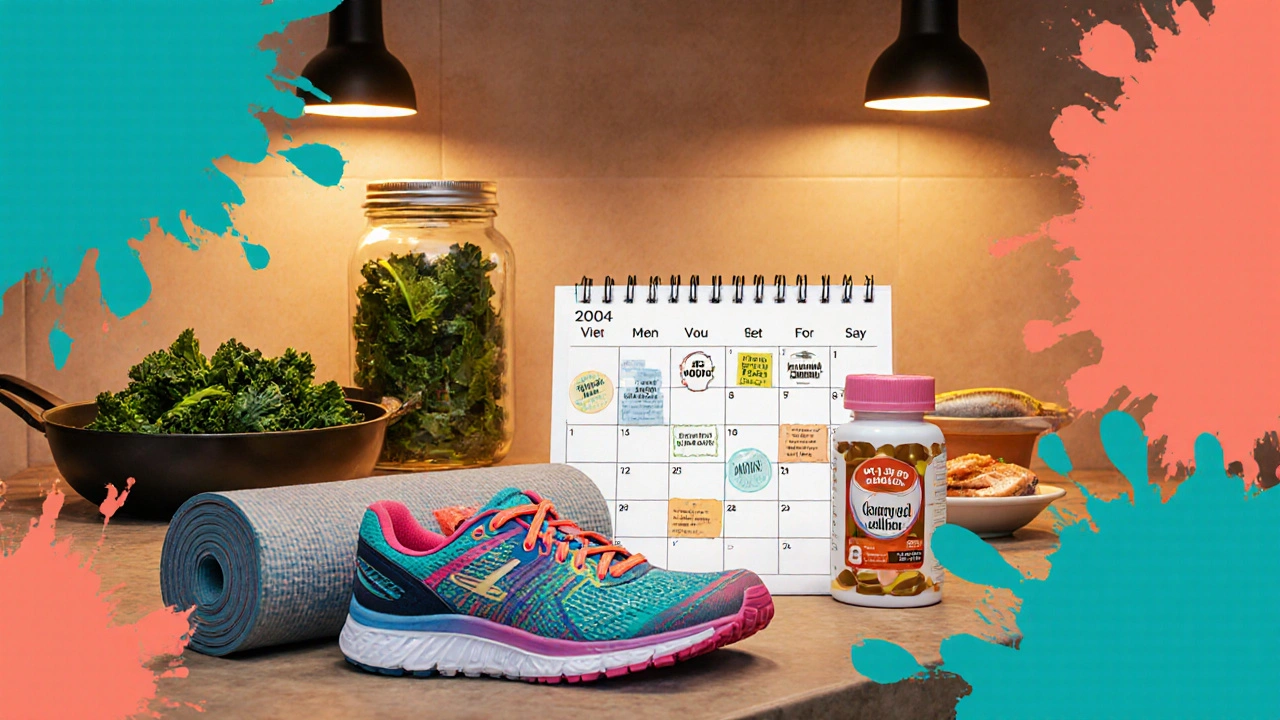
Medical Options When Lifestyle Isn’t Enough
If your DEXA results show a T‑score below -1.0, or you’ve already suffered a fragility fracture, doctors will look at prescription pathways.
| Intervention | Mechanism | Typical Dose | Pros | Cons |
|---|---|---|---|---|
| Calcium supplement provides the mineral needed for bone formation | Direct mineral source | 1,000-1,200mg/day | Easy, inexpensive | Kidney stones if over‑taken; limited effect alone |
| Vitamin D supplement enhances calcium absorption in the gut | Boosts calcium uptake | 800-1,000IU/day | Reduces fall risk | Rare toxicity at very high doses |
| Bisphosphonates inhibit osteoclast activity, slowing bone loss | Anti‑resorptive | Alendronate 70mg weekly | Proven fracture reduction (30‑50%) | Esophageal irritation, rare jaw osteonecrosis |
| Hormone Replacement Therapy (HRT) replaces estrogen to maintain bone remodeling balance | Estrogen‑based anti‑resorptive | Transdermal 0.025mg estradiol weekly | Effective for early post‑menopause, also relieves hot flashes | Potential breast cancer risk, requires thorough evaluation |
| Selective Estrogen Receptor Modulators (SERMs) mimic estrogen’s bone benefits without stimulating breast tissue | Bone‑selective estrogen agonist | Raloxifene 60mg daily | Reduces vertebral fracture risk | Can cause hot flashes, increased VTE risk |
Choosing the right option depends on personal risk factors, age, kidney function, and preference for oral vs. injectable routes. A bone‑specialist (rheumatologist or endocrinologist) can run a risk‑assessment calculator - the FRAX tool - and match you to the most suitable regimen.
Putting It All Together: A 12‑Month Prevention Plan
Below is a month‑by‑month road map. Feel free to adapt it to your schedule.
| Month | Focus | Key Actions |
|---|---|---|
| 1-2 | Baseline assessment | Schedule a DEXA scan, complete FRAX questionnaire, review medication list for bone‑impacting drugs. |
| 3-4 | Nutrition reset | Track calcium and vitamin D intake; start a supplement if needed; limit caffeine to ≤2 cups. |
| 5-6 | Exercise habit | Join a walking group or low‑impact aerobics class; add two 15‑minute resistance sessions (bodyweight or bands). |
| 7-8 | Medical review | If DEXA T‑score ≤ -1, discuss bisphosphonate or HRT with GP; consider referral to bone clinic. |
| 9-10 | Lifestyle fine‑tuning | Quit smoking if applicable, limit alcohol to ≤1 drink/week, ensure 7‑8h sleep for hormonal balance. |
| 11-12 | Re‑evaluate | Repeat DEXA (if advised) or check serum calcium/Vit D levels; adjust supplement doses. |
Stick with this plan for at least a year before expecting measurable BMD changes. Remember, the goal isn’t to halt every tiny loss, but to keep it well below the fracture‑risk threshold.
Frequently Asked Questions
Can I prevent osteoporosis after menopause without medication?
Yes. A diet rich in calcium (1,200mg/day) and vitamin D (800‑1,000IU/day), paired with regular weight‑bearing activity, can keep bone loss under 1% per year - a rate that rarely leads to fractures. However, if your DEXA T‑score is ≤ -2.0, medication adds a significant safety net.
How often should I get a DEXA scan?
The NHS advises a baseline scan at age50-55 for most women, then every 5years if results are normal. If you have risk factors (family history, low BMI, glucocorticoid use), ask for a repeat every 2-3years.
Is hormone replacement therapy safe for bone health?
For women under 60 or within 10years of menopause, transdermal HRT can reduce vertebral and hip fracture risk by up to 30%. It also eases hot flashes. Women with a personal or family history of breast cancer should discuss alternatives with their clinician.
Can I take calcium and vitamin D together?
Absolutely. In fact, vitamin D improves calcium absorption by up to 40%. The best practice is to split calcium doses (500mg twice daily) and take vitamin D with the first calcium dose.
What foods are highest in calcium besides dairy?
Sardines with bones, fortified soy or oat milk, tofu set with calcium sulfate, kale, bok choy, and almonds each provide 100‑300mg per serving. Pair them with vitamin D‑rich foods like salmon or eggs for optimal uptake.
bone health after menopause isn’t a matter of luck - it’s about informed choices, regular checks, and a mix of diet, movement, and, when needed, medicine. Start with a DEXA scan, build a calcium‑rich plate, move your body daily, and keep the conversation open with your doctor. Your skeleton will thank you for years to come.

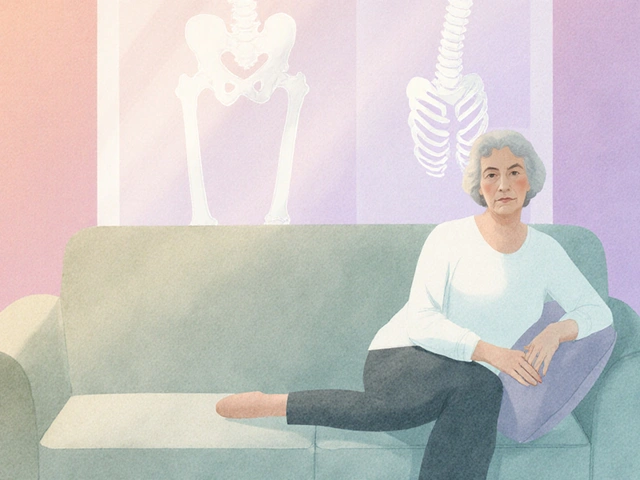

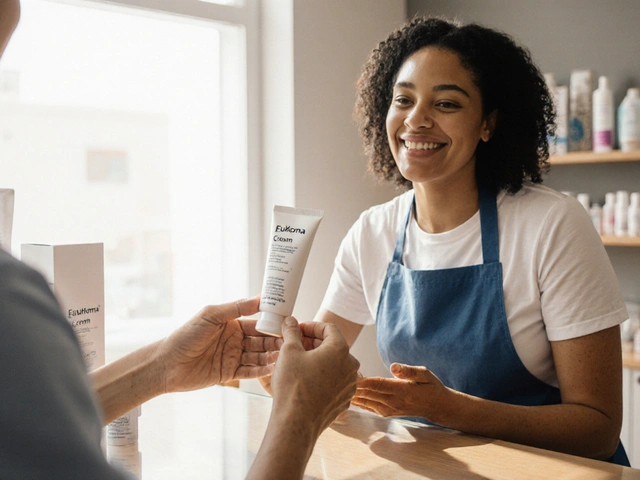
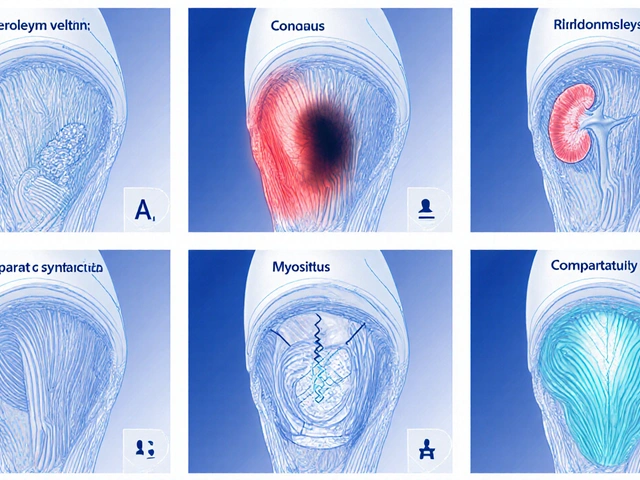
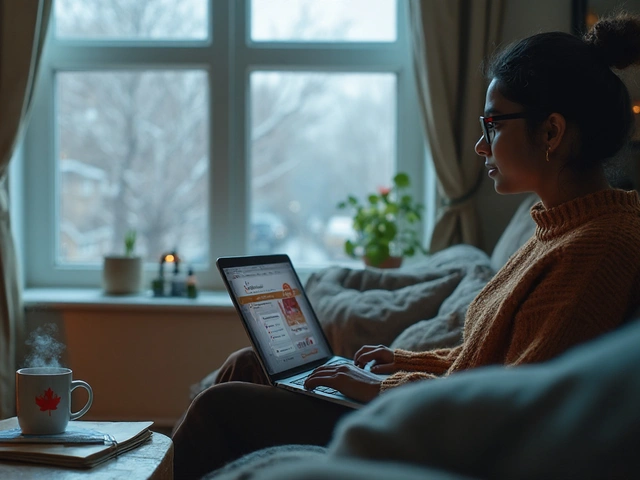
Nicole Koshen
Thanks for sharing this bone health assessment tool. It’s crucial for women hitting menopause to understand how their lifestyle choices affect bone density. Incorporating weight‑bearing exercises like walking or resistance training can really help maintain bone mass. Also, making sure you get enough calcium-about 1,200 mg daily-and vitamin D, either through sunlight or supplements, is essential. Lastly, regular DEXA scans can catch density loss early, allowing timely intervention.
Ed Norton
Agree. A quick walk each day does wonders.
Karen Misakyan
One must consider that the cessation of ovarian estrogen production heralds a cascade of metabolic alterations, not merely a simple deficiency of a single hormone. The decline in estrogen directly augments osteoclast activity, thereby accelerating bone resorption. Simultaneously, the reduction in intestinal calcium absorption necessitates a higher dietary intake to compensate for the loss. Studies have demonstrated that postmenopausal women who achieve a serum 25‑hydroxyvitamin D level above 30 ng/mL exhibit a statistically significant reduction in fracture incidence. Moreover, the interplay between vitamin K2 and matrix Gla‑protein further modulates mineralization, an aspect often overlooked in lay discussions. A comprehensive approach, therefore, must include adequate calcium (1,200 mg per day) and vitamin D (800–1,000 IU daily), but also consideration of magnesium and phosphorus balance. In addition, resistance training, such as weight machines or free‑weight exercises performed 2–3 times per week, provides mechanical stimulus indispensable for bone formation. The mechanical loading induces osteoblast differentiation via the Wnt/β‑catenin pathway, counteracting the estrogen‑related bone loss. Pharmacologic options, including bisphosphonates, selective estrogen receptor modulators, or newer agents like denosumab, should be evaluated by a healthcare professional based on individual risk stratification. A bone density test (DXA) is recommended at the onset of menopause, with follow‑up scans every 1–2 years depending on baseline T‑scores. Lifestyle modifications also play a pivotal role; smoking cessation reduces oxidative stress on bone cells, while limiting alcohol intake (<2 drinks per day) mitigates calcium excretion. Finally, dietary sources rich in calcium-dairy products, fortified plant milks, leafy greens-should be prioritized over high‑phosphate soft drinks which can disrupt calcium homeostasis. In sum, menopause does not consign women to inevitable skeletal fragility; a proactive, multifactorial regimen can preserve bone integrity well into the later decades of life.
Amy Robbins
Wow, someone wrote a novel. Most folks just need a pill and a stroll, not a dissertation.
Michelle Zhao
The drama of losing bone can be mitigated with a proper regimen. Firstly, calcium and vitamin D are non‑negotiables. Secondly, resistance training should be structured-think squats, lunges, deadlifts. Thirdly, avoid excessive caffeine as it may leach calcium. Finally, consider speaking with an endocrinologist about hormone replacement if appropriate.
Eric Parsons
Spot on. A balanced program covers nutrition, exercise, and medical oversight.
Mary Magdalen
Let’s paint the picture: you’re skipping the gym, drinking soda, and ignoring the calcium label. Suddenly, a fracture lands you in the ER. The path to prevention is simple-move, eat, supplement, and check your bones regularly.
Dhakad rahul
😂 Skipping the gym is a crime against your femur! ✨
William Dizon
I’ve seen many patients benefit from a daily calcium‑rich smoothie plus a quick set of body‑weight squats. It’s a small habit that adds up over years.
Jenae Bauer
Did you know the government hides the real data on bone loss? They want us confused while they profit from supplements. Stay critical.
vijay sainath
Bro, that’s a conspiracy. Just take your meds.
Daisy canales
Great info, thanks!
keyul prajapati
While a single sentence can convey gratitude, it is also worthwhile to elaborate on why this topic matters. Menopause marks a turning point where estrogen‑mediated protection wanes, placing women at increased risk for osteoporosis. Therefore, initiatives that raise awareness, such as this assessment tool, are invaluable. They empower individuals to take charge of their health before irreversible damage occurs. Moreover, communal sharing of experiences can foster support networks that encourage adherence to preventive measures.
Alice L
In the annals of public health, disseminating culturally sensitive information remains paramount. This guide respectfully acknowledges diverse dietary practices while emphasizing universal tenets of bone preservation. May it serve as a beacon for women across all backgrounds navigating the menopausal transition.
Seth Angel Chi
Interesting perspective, though the data is over‑hyped.
Kristen Ariies
Hey everyone! Let’s keep the momentum going-your bones deserve the best! 🚀 Start with a calcium‑rich breakfast, then hit those stairs instead of the elevator. Don’t forget a quick 10‑minute stretch session before bed; it improves circulation and bone health. Celebrate every small victory, because consistency is the real hero here! Keep sharing your progress, and let’s crush osteoporosis together! 💪
Mary Latham
Yo, I vibed with that. Just remember, supplement srticts r key. Dont skip 'em.
Marie Green
I appreciate the positive energy. Adding a daily walk and a glass of fortified soy milk can make a real difference.